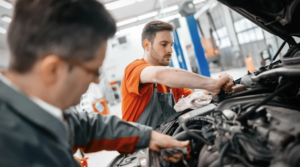As an automotive enthusiast, I’ve always been fascinated by the advancements in vehicle technology. However, with the rise of connected cars, the issue of cybersecurity has become more critical than ever. In today’s digital age, cars are no longer just mechanical marvels; they are rolling computers on wheels.
When we think about automotive cybersecurity, we’re not just talking about protecting personal data or financial information. We’re delving into the realm of potential safety threats and the implications of cyber-attacks on our daily commutes. As cars become more integrated with the internet and various devices, the need for robust cybersecurity measures is paramount to ensure not only data privacy but also the physical safety of drivers and passengers.
Automotive Cybersecurity
Risks Associated With Connectivity
 In today’s automotive landscape, the integration of technology, including the use of QR codes for various functionalities, has brought forth numerous benefits, but it has also introduced new risks. As vehicles become more connected, they are increasingly vulnerable to cyber threats. Hackers can exploit these connections to gain unauthorized access to critical systems, posing dangers to both personal safety and data security.
In today’s automotive landscape, the integration of technology, including the use of QR codes for various functionalities, has brought forth numerous benefits, but it has also introduced new risks. As vehicles become more connected, they are increasingly vulnerable to cyber threats. Hackers can exploit these connections to gain unauthorized access to critical systems, posing dangers to both personal safety and data security.
The trust between consumers and automakers is paramount in the automotive industry. However, the rise of cyber threats has the potential to erode this trust. Instances of successful cyber-attacks on vehicles can lead to significant reputational damage for manufacturers, impacting consumer confidence in the brand and its products. Consumers expect their personal and financial information to be secure when using connected services in vehicles.
Key Threats in Automotive Cybersecurity
External Hacking Attempts
 As an expert in automotive cybersecurity, I recognize that external hacking attempts pose a significant threat to the industry. Cybercriminals are constantly evolving their tactics to target vulnerabilities in connected vehicles. These malicious actors may exploit weaknesses in software systems or intercept wireless communications to gain unauthorized access to a car’s network.
As an expert in automotive cybersecurity, I recognize that external hacking attempts pose a significant threat to the industry. Cybercriminals are constantly evolving their tactics to target vulnerabilities in connected vehicles. These malicious actors may exploit weaknesses in software systems or intercept wireless communications to gain unauthorized access to a car’s network.
In the realm of automotive cybersecurity, software vulnerabilities are a pressing concern that demands attention. The complexity of modern vehicle software, coupled with the interconnected nature of car systems, creates opportunities for exploitation. Flaws in code or inadequate security measures can be exploited by cyber attackers to infiltrate a car’s network. These vulnerabilities can result in unauthorized access to sensitive data, remote control of vehicle operations, or even total immobilization of the vehicle, highlighting the critical need for robust cybersecurity protocols in the automotive industry.
Defensive Strategies for Protecting Vehicles
Encryption and Secure Communication Protocols
 Ensuring strong encryption and implementing secure communication protocols are vital in safeguarding vehicles against potential cyber threats. By encrypting data transmissions and leveraging secure communication protocols, such as Transport Layer Security (TLS), it’s possible to protect sensitive information exchanged between vehicle components and external systems.
Ensuring strong encryption and implementing secure communication protocols are vital in safeguarding vehicles against potential cyber threats. By encrypting data transmissions and leveraging secure communication protocols, such as Transport Layer Security (TLS), it’s possible to protect sensitive information exchanged between vehicle components and external systems.
Regular software updates and effective patch management are crucial components of maintaining cybersecurity in vehicles. Manufacturers and software developers must promptly address and patch any identified vulnerabilities to enhance the overall security posture of automotive systems. By consistently updating software and applying patches to address known security flaws, potential entry points for cyber attacks can be minimized.
Challenges and Future Perspectives
Evolving Technological Threats
Staying ahead of evolving technological threats is a constant battle in the automotive industry. As vehicles become more connected and reliant on software systems, the potential attack surfaces for cyber threats increase. Hackers are continually developing sophisticated methods to exploit vulnerabilities in connected cars, putting personal data and even physical safety at risk.
Adhering to international standards and regulations is essential to establish a unified approach to automotive cybersecurity. With the global nature of the automotive industry, harmonized regulations help ensure that cybersecurity measures are consistently implemented across different markets. Standards such as ISO/SAE 21434 and UN Regulation No. 155 play a vital role in guiding manufacturers towards robust cybersecurity practices.

